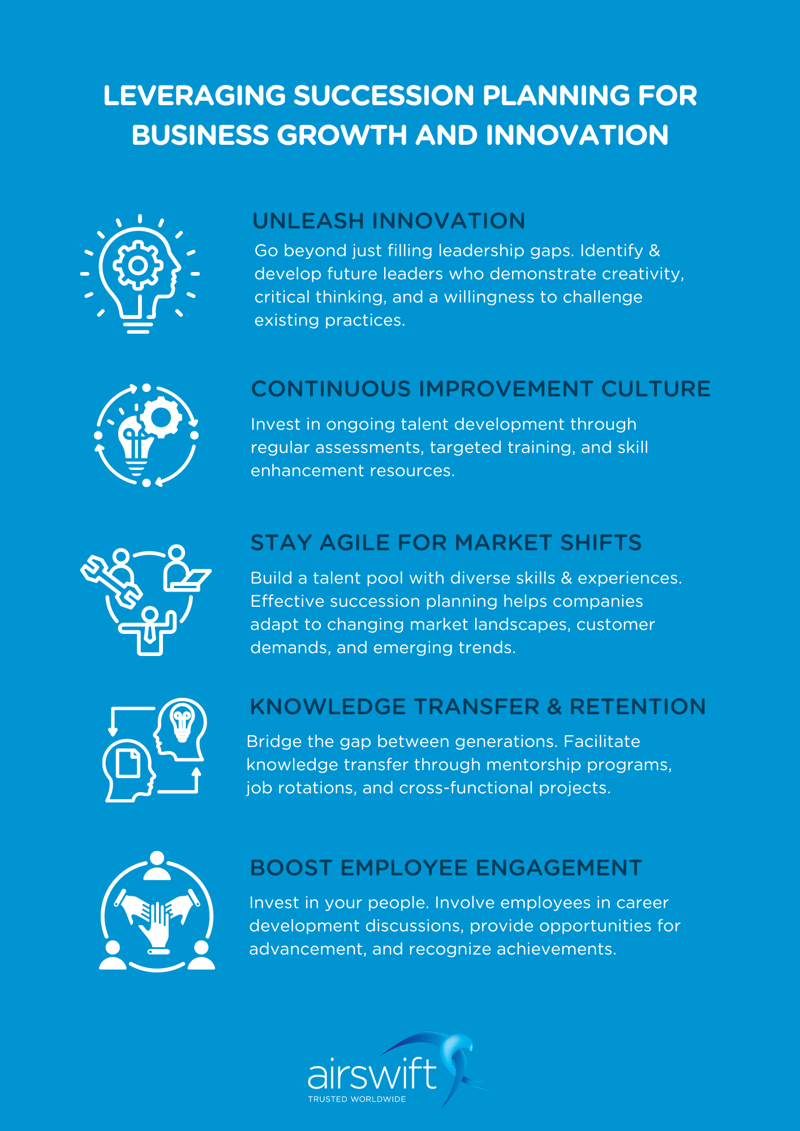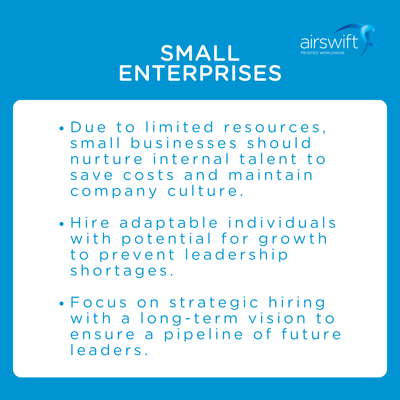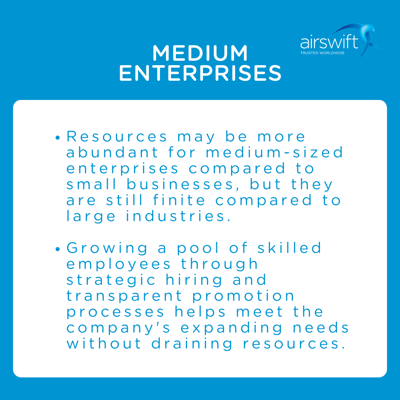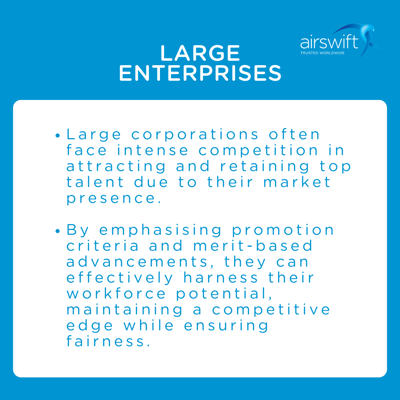How to create a succession plan for business continuity and growth
April 2, 2024
- Home
- Blog

What is succession planning, and why is it so important?
Succession planning is vital to organisational development and extends beyond the C-suite and upper management roles. It's essential for all levels of an organisation, ensuring a seamless transition of talent and skills.
Following are the topics we will cover in this article:
- Succession planning definition
- Key elements of an effective succession plan
- Risk mitigation and adaptation strategies
- Implementing succession plans for mission-critical roles
- How to create a succession plan
- Succession planning case studies: Implementing in various business contexts
- Common succession planning challenges and how to overcome them
- Key takeaways
- Invest in your business' future with Airswift
Let's start with a clear succession planning definition
Succession planning is the process of identifying and preparing promising executives for greater future responsibilities and is significant in modern business environments because it ensures leadership continuity and success.
According to Neil Manfred, Group IT Director at Airswift, "Succession planning is about making sure the whole organisation continues to run smoothly by identifying reliable individuals."
The two main components of succession planning encompass staff retention and talent development.
Staff retention
Staff retention is critical for maintaining business continuity and growth. It involves strategies and practices to retain talented employees and reduce turnover rates.
Says Charles Pfauwadel, Senior Vice President of ASPAC at Airswift, succession planning is "by far the best way to retain people because the longer someone is with the organisation, the more they contribute because they have fostered strong relationships with clients and within the business."
- Boosts morale and motivation: Recognition of potential through succession planning increases employee commitment and drive.
- Demonstrates investment: Training, mentorship, and leadership development programs show the company values employee growth.
- Reduces turnover costs: Investing in existing employees reduces recruitment and training costs associated with high turnover.
-
Career path clarity: Defined career paths within succession planning keep employees engaged and motivated.
Career progression is very much linked to succession planning. We want to make sure leaders elevate and promote team members, which often leads to replacing managers and opening up new roles.
– Charles Pfauwadel
Talent development
Talent development in succession planning is integral to a robust and adaptable workforce. "Empowering individuals based on their strengths and interests can contribute significantly to the organisation. In technical fields such as IT, tailoring projects based on what individuals enjoy doing can lead to remarkable achievements, such as leading ISO certification efforts," says Manfred.
Here are several benefits to developing talent:
- Identifies and nurtures potential: Programs assess skills and potential to develop future leaders from within.
- Enhances skills and competencies: Training focuses on leadership, communication, and decision-making to prepare employees for future challenges.
- Adapts to changing needs: Programs evolve alongside the business landscape to ensure employees have the latest skills needed for success.
- Improves succession readiness: Investing in development creates a pipeline of prepared leaders to mitigate risks from staff departures. Pfauwadel emphasises that succession planning helps businesses anticipate sudden changes. "It ensures tasks and knowledge are not lost overnight and allows for preparation and training in advance." he says.
- Fosters continuous learning: A culture of ongoing growth is encouraged through employee development opportunities.
 Image source: Scott Graham on Unsplash
Image source: Scott Graham on Unsplash
Key elements of effective succession planning
Succession planning is a theoretical exercise and builds organisational resilience. A robust succession plan comprises several components that ensure its success in identifying, nurturing, and transitioning talent.
Proactive training and skills documentation
Effective succession plans begin with identifying and documenting critical skills and competencies for various roles. Training programs are then implemented to develop these skills among employees, ensuring they are well-prepared to step into leadership positions.
Leadership pipeline creation
Establishing a leadership pipeline involves identifying high-potential employees and providing them with opportunities for advancement and development. This includes rotational assignments, stretch assignments, and targeted development programs designed to groom future leaders from within the organisation.
Mentorship and coaching programs
These play a crucial role in succession planning by providing guidance and support to emerging leaders. Experienced executives can mentor younger employees, sharing their knowledge, insights, and experiences to help them develop leadership skills. According to Pfauwadel, "it's all about identifying high-potential people as early as possible and supporting their development and growth.”
Succession readiness assessments
Regular assessments are conducted to evaluate the readiness of potential successors to step into key roles. This may include performance reviews, competency assessments, and leadership potential evaluations to identify gaps and development areas.
Contingency planning
"Being ready for unexpected situations is crucial. If someone resigns, and you don't have succession planning in place, especially if this person is a salesperson, for example, you may lose the business because you don't have a backup plan."
- Charles Pfauwadel
Effective succession planning includes contingency planning for unexpected events such as sudden departures, retirements, or incapacitation of key personnel. Contingency plans outline alternative strategies for filling critical roles on short notice, minimising disruption to business operations.
The role of open communication and collaborative goal-setting
I'm a massive believer in one-to-ones with my direct reports, speaking at least once a week. I want everybody to feel like they can come to me and say, ‘Hey, I'm struggling with this area’, without worrying about retribution or retaliation.
-Neil Manfred
Open communication and collaborative goal-setting are essential to a transparent and aligned organisation. Employees who feel empowered to share ideas bring diverse perspectives to inform decisions and spark innovation.
Collaborative goal setting ensures everyone understands the company's vision and their role in achieving it, fostering a sense of ownership, boosting motivation and productivity. This combination creates a high-performing workforce.
 Image source: KOBU Agency on Unsplash
Image source: KOBU Agency on Unsplash
Risk mitigation and adaptation strategies
Succession planning involves identifying and mitigating risks associated with leadership transitions. The steps highlighted below ensure business continuity in the face of unforeseen challenges.
Diversifying the leadership pipeline
Succession planning involves diversifying the leadership pipeline. This includes identifying and developing a pool of talented individuals across different departments and levels of the organisation who have the potential to step into leadership roles. By broadening the talent pool, organisations can reduce dependency on specific individuals and increase resilience to unexpected departures or changes in leadership.
Cross-training employees
Cross-training employees is an effective strategy for building versatility and flexibility within the workforce. Organisations can ensure that multiple individuals can perform critical tasks and responsibilities by providing opportunities for employees to gain experience and skills outside their primary roles.
Succession planning is about finding individuals who have the inclination to move into another area. It's about giving them a well-rounded ability across each department.
– Neil Manfred
Implementing succession plans for mission-critical roles
Specific roles within an organisation are essential for maintaining business operations and continuity. Succession planning involves identifying these mission-critical roles and developing specific succession plans to ensure qualified individuals are ready to step in when needed.
With good succession planning, you can smoothly transition someone new into a vacant role. It's all about ensuring the company can plan and think long-term.
- Charles Pfauwadel
Scenario planning and contingency plans
Organisations engage in scenario planning to anticipate and prepare for various potential outcomes and challenges associated with leadership transitions. This involves identifying potential scenarios, assessing their likelihood and impact, and developing contingency plans to address them.
Regular review and updates
Risk mitigation and adaptation strategies should be regularly reviewed and updated to reflect changes in the organisational landscape and evolving business priorities. Succession plans should be dynamic and responsive to emerging risks and opportunities, with regular assessments to ensure effectiveness.
 Image source: Headway on Unsplash
Image source: Headway on Unsplash
How to create a succession plan
Effective succession planning involves deliberate strategies to identify, nurture, and prepare talent to seamlessly transition into key roles. This ensures organisational resilience and long-term success.
Here are eight ways to ensure effective succession planning strategies:
-
Start early: Begin succession planning well in advance. Preparing multiple candidates for key positions to address sudden changes and aligning this process with your company's growth objectives for a steady stream of leadership talent is vital.
-
Be open-minded: Cultivate high-potential employees at all levels. Overlooking seniority, focus on the skills and attitudes needed for leadership roles. Promote a culture where growth and learning are supported through training and mentorship.
-
Document skills: Keep detailed records of employees' skills, roles, and job requirements. Update these regularly to mirror any shifts in responsibilities, laying the groundwork for promotions and identifying areas for improvement.
-
Identify skill gaps: Regularly assess employees to spot skill shortages, using this analysis to guide development plans. This keeps your succession plan informed and targeted.
-
Engage and align: Foster transparent discussions about employees' career goals, aligning their aspirations with the company's needs. This collaboration ensures mutual benefits and satisfaction.
-
Plan together: Collaborate with managers to tailor succession strategies, offering tools and advice to harness their insight into team dynamics and potential leaders.
-
Practice and assess: Use temporary leadership roles, like covering for vacations, as trial periods to evaluate candidates' readiness, providing feedback and additional training where necessary.
-
Hire strategically: Align your hiring strategy with your succession plan, leveraging internal talent evaluations to guide external recruitment, thereby maintaining a consistent approach to talent development and leadership continuity.

Succession planning case studies: Implementing in various business contexts
Succession planning is dynamic and should be tailored to various businesses' unique characteristics.
This requires a nuanced understanding of organisational structures, resources, and cultures in small, medium, or large enterprises.
Small enterprise: Huntswood

Succession planning for Huntswood is focused on its 226 employees and 4,000 contractors. This highlights the company's commitment to internal development and talent management.
Strategy
Huntswood's succession planning strategy extends beyond its employees to include contractors, emphasising the importance of building a solid leadership pipeline. The company's approach involves strategic hiring and developing internal successors to ensure continuity in key roles.
Results
Huntswood's proactive approach to succession planning showcases the company's dedication to regulatory compliance, quality, and customer outcomes. By focusing on internal development and talent management, Huntswood positions itself to navigate challenges and sustain leadership continuity effectively.
Medium enterprise: GoPro
Adapting leadership to a rapidly changing market for wearable technology, GoPro faced intense competition and needed leaders who could navigate this dynamic environment.

Strategy
GoPro's approach has been more reactive at times. Nick Woodman, the founder and long-time CEO, stepped down in 2020. The company brought outsiders with experience in areas like enterprise software (CEO Lisa Su from AMD) to address their evolving needs.
Results
Flexibility is needed for medium-sized companies in fast-paced industries. They may need to look outside for specific expertise while nurturing internal talent.
Large enterprise: Samsung
For Samsung, its main challenge was maintaining stability and growth for a complex multinational corporation with a family-oriented leadership structure.

Strategy
The multinational conglomerate utilises a multi-pronged approach. They strongly focus on internal development through programs like the Samsung Leadership Institute, which grooms future leaders from within the company. Additionally, they leverage their global presence by considering qualified candidates from various regions for leadership roles.
Results
Samsung has seen relatively smooth leadership transitions despite its complex structure. This can be attributed to their focus on internal development and a global talent pool.
Common succession planning challenges and how to overcome them
Organisations can maximise succession planning efforts and ensure long-term success by proactively addressing and overcoming common challenges.
Resistance to change
Prioritise clear communication and transparency throughout the succession planning process to overcome resistance to change.
Engage employees in open dialogue about the rationale behind succession planning and its benefits to individuals and the organisation. Provide support and resources to help employees adapt to new roles, emphasising the opportunities for growth and development.
Lack of resources
Prioritise resource allocation for succession planning, recognising it as a strategic investment in long-term sustainability.
This involves investing in training, technology for talent management, and allocating time and personnel for succession planning. Additionally, organisations can explore partnerships with external consultants or educational institutions to supplement internal resources.
Inadequate leadership buy-in
Emphasise the strategic importance of succession planning and its alignment with broader organisational goals to cultivate leadership buy-in.
Provide education and training for senior leaders on the benefits of succession planning and their role in its success. Encourage leaders to actively engage in talent development efforts and lead by example in promoting a culture of succession readiness and continuous learning.
Insufficient talent development
Prioritise talent development as a core component of succession planning.
Implement structured training programs, mentorship initiatives, and leadership development courses to nurture the skills and capabilities of high-potential employees.
Encourage continuous learning and skill-building at all levels of the organisation, empowering employees to take ownership of their career growth and advancement.
Lack of talent pool diversity
Prioritise diversity and inclusion in their succession planning efforts, actively seeking and developing talent from diverse backgrounds.
Implement strategies to remove biases from talent identification and selection processes, such as blind screening techniques or structured interview protocols. Foster an inclusive culture where all employees feel valued and empowered to contribute their unique perspectives and talents.
Succession plan rigidity
Design flexible succession plans, allowing for adjustments based on changing circumstances and emerging talent trends.
Incorporate regular reviews and updates into the succession planning process to ensure alignment with evolving business strategies and talent priorities. Encourage a culture of agility and adaptability, where employees are encouraged to explore new roles and opportunities for growth within the organisation.
Key takeaways
- Succession planning is proactive, not reactive. Don't wait for a crisis to hit. Begin cultivating your future leaders today.
- It's a continuous process, not a one-time event. Regularly re-evaluate and adapt your plan to align with evolving needs and opportunities.
- Benefits extend far beyond filling key roles. A well-implemented plan fosters employee engagement, knowledge transfer, innovation, and organisational resilience.
- Communication and collaboration are key. Transparent discussions, collaborative goal-setting, and open career development pathways build trust and motivation.
- It's an investment in your future. You secure your organisation's long-term sustainability and success by nurturing talent and preparing for transitions.
- Succession planning is not just for giant corporations or impending CEO retirements; it's a strategic approach applicable to any organisation.
 Image source: krakenimages on Unsplash
Image source: krakenimages on Unsplash
Invest in your business' future with Airswift
Organisations can weather changes and thrive in an ever-evolving landscape by prioritising succession planning as a strategic investment.
At Airswift, we understand the importance of talent management and succession planning in driving business continuity and growth. Whether you seek strategic workforce solutions or expert guidance in mobilising international talent we can support your journey towards a resilient and sustainable future.
Reach out to us today to learn how we can partner with you to secure your organisation's long-term success.
This post was written by: Diyaa Mani, Content Marketing Coordinator
You may also be interested in…
-
Why the world's most innovative businesses are flocking to Singapore
-
The importance of cultural awareness in international business
-
How to support diverse employee work styles and drive collaboration
-
How to implement an effective remote working strategy
-
International expansion strategy: mistakes to avoid
-
Focus on these five criteria to improve global employee engagement
-
From team member to leader: Empowering employees for management success
-
Papua New Guinea: The future of the labour market
-
11 steps to surviving the first week of your new job
-
15 things you should never say in a job interview



